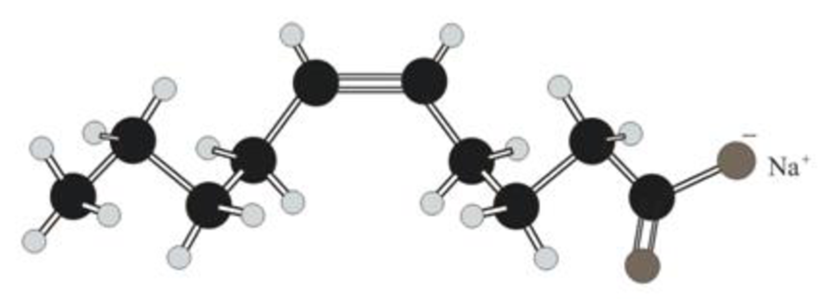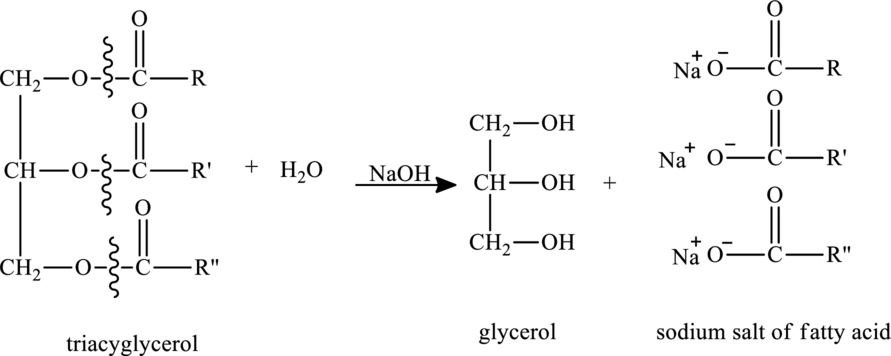
PRIN.OF GENERAL,ORGANIC+BIOLOG.CHEM.
2nd Edition
ISBN: 9781266811852
Author: SMITH
Publisher: MCG
expand_more
expand_more
format_list_bulleted
Concept explainers
Question
Chapter 15, Problem 15.53AP
Interpretation Introduction
Interpretation:
Structure of triacylglycerol produced from below structure has to be drawn.

Concept Introduction:
Triacylglycerols are lipids that are formed by two or more similar or different fatty acids. They are also called triglycerides and are hydrophobic and nonpolar in nature. Addition of glycerol and three similar or different fatty acids results into triesters that is triacylglycerols.
Basic hydrolysis of triacylglycerol with water in presence of base produces metal salt of fatty acid and alcohol. The reaction that explains the basic hydrolysis of triacylglycerol is as follows:

Here,
Expert Solution & Answer
Want to see the full answer?
Check out a sample textbook solution
Students have asked these similar questions
2. Calculate the branching ratio of the reaction of the methyl peroxy radical with either HO, NO
298K) (note: rate constant can be found in the tropospheric chemistry ppt
CH,O,+NO-HCHO+HO, + NO,
CH₂O+HO, CH₂00H +0₂
when the concentration of hydroperoxyl radical is DH01-1.5 x 10 molecules and the
nitrogen oxide maxing ratio of 10 ppb
when the concentration of hydroperoxyl radicalis [H0] +1.5x10 molecules cm" and the
nitrogen oxide mixing ratio of 30 p
Under which condition do you expect more formaldehyde to be produced and why
Indicate the product of the reaction of benzene with 1-chloro-2,2-dimethylpropane in the presence of AlCl3.
In what position will N-(4-methylphenyl)acetamide be nitrated and what will the compound be called.
Chapter 15 Solutions
PRIN.OF GENERAL,ORGANIC+BIOLOG.CHEM.
Ch. 15.1 - In which solvents or solutions will a lipid be...Ch. 15.2 - (a) Draw a skeletal structure for each fatty acid....Ch. 15.2 - Prob. 15.3PCh. 15.2 - Prob. 15.4PCh. 15.3 - Draw the structure of a wax formed from stearic...Ch. 15.3 - One component of jojoba oil is a wax formed from...Ch. 15.3 - What hydrolysis products are formed when cetyl...Ch. 15.4 - Draw the structure of a triacylglycerol that...Ch. 15.4 - Prob. 15.9PCh. 15.4 - Draw the structure of a triacylglycerol that fits...
Ch. 15.5 - Draw the products formed from hydrolysis of each...Ch. 15.5 - Prob. 15.12PCh. 15.6 - Draw the structure of two different cephalins...Ch. 15.6 - Classify each lipid as a triacylglycerol,...Ch. 15.7 - Why are phospholipids rather than triacylglycerols...Ch. 15.7 - Prob. 15.16PCh. 15.8 - Prob. 15.17PCh. 15.8 - Prob. 15.18PCh. 15.9 - Prob. 15.19PCh. 15.9 - Prob. 15.20PCh. 15.10 - Why is it much easier to overdose on a fat-soluble...Ch. 15.10 - Prob. 15.22PCh. 15 - Prob. 15.23UKCCh. 15 - Prob. 15.24UKCCh. 15 - Prob. 15.25UKCCh. 15 - What hydrolysis products are formed when the wax...Ch. 15 - Prob. 15.27UKCCh. 15 - Prob. 15.28UKCCh. 15 - Draw the products formed when the given...Ch. 15 - Prob. 15.30UKCCh. 15 - Prob. 15.31UKCCh. 15 - Prob. 15.32UKCCh. 15 - Prob. 15.33APCh. 15 - Label each compound as a hydrolyzable or...Ch. 15 - Prob. 15.35APCh. 15 - Prob. 15.36APCh. 15 - Prob. 15.37APCh. 15 - How does each of the following affect the melting...Ch. 15 - Rank the fatty acids in order of increasing...Ch. 15 - How would you expect the melting points of the...Ch. 15 - Prob. 15.41APCh. 15 - Why are soaps water soluble, but the fatty acids...Ch. 15 - Draw the structure of a wax formed from palmitic...Ch. 15 - Prob. 15.44APCh. 15 - Prob. 15.45APCh. 15 - Prob. 15.46APCh. 15 - Prob. 15.47APCh. 15 - What hydrolysis products are formed when each wax...Ch. 15 - Draw a triacylglycerol that fits each description:...Ch. 15 - Draw a triacylglycerol that fits each description:...Ch. 15 - Prob. 15.51APCh. 15 - Prob. 15.52APCh. 15 - Prob. 15.53APCh. 15 - Prob. 15.54APCh. 15 - Prob. 15.55APCh. 15 - Draw the products formed when the given...Ch. 15 - Prob. 15.57APCh. 15 - Prob. 15.58APCh. 15 - Prob. 15.59APCh. 15 - Prob. 15.60APCh. 15 - Prob. 15.61APCh. 15 - Why are LDLs soluble in the blood?Ch. 15 - Describe the role of HDLs and LDLs in cholesterol...Ch. 15 - Prob. 15.64APCh. 15 - Prob. 15.65APCh. 15 - Prob. 15.66APCh. 15 - Answer each question with regards to vitamins A...Ch. 15 - Answer each question in Problem 15.67 for vitamins...Ch. 15 - Prob. 15.69APCh. 15 - Prob. 15.70APCh. 15 - Prob. 15.71APCh. 15 - How are soaps and phosphoacylglycerols similar in...Ch. 15 - Some fish oils contain triacylglycerols formed...Ch. 15 - Some marine plankton contain triacylglycerols...Ch. 15 - Prob. 15.75APCh. 15 - Prob. 15.76APCh. 15 - Prob. 15.77APCh. 15 - Prob. 15.78APCh. 15 - Prob. 15.79CPCh. 15 - Prob. 15.80CP
Knowledge Booster
Learn more about
Need a deep-dive on the concept behind this application? Look no further. Learn more about this topic, chemistry and related others by exploring similar questions and additional content below.Similar questions
- DATA: Standard Concentration (caffeine) mg/L Absorbance Reading 10 0.322 20 0.697 40 1.535 60 2.520 80 3.100arrow_forwardIn what position will p-Toluidine be nitrated and what will the compound be called.arrow_forwardIn what position will 4-methylbenzonitrile be nitrated and what will the compound be called.arrow_forward
- In what position will benzenesulfonic acid be nitrated?arrow_forwardIf compound A reacts with an excess of methyl iodide and then heated with aqueous Ag₂O, indicate only the major products obtained. Draw their formulas. A Harrow_forwardExplanation Check 1:01AM Done 110 Functional Groups Identifying and drawing hemiacetals and acetals In the drawing area below, create a hemiacetal with 1 ethoxy group, 1 propoxy group, and a total of 9 carbon atoms. Click and drag to start drawing a structure. ✓ $ 2025 McGraw Hill LLC. All Rights Reserved. Terms of Use Sarrow_forward
- Write the systematic name of each organic molecule: CI structure CI CI Explanation CI ठ CI Check B ☐ 188 F1 80 name F2 F3 F4 F5 F6 60 F7 2arrow_forwardWrite the systematic name of each organic molecule: structure i HO OH Explanation Check name ☐ ☐arrow_forwardX 5 Check the box under each molecule that has a total of five ẞ hydrogens. If none of the molecules fit this description, check the box underneath the table. CI Br Br Br 0 None of these molecules have a total of five ẞ hydrogens. Explanation Check esc F1 F2 tab caps lock fn Q @2 A W # 3 OH O OH HO © 2025 McGraw Hill LLC. All Rights Reserved. Terms of Use | Privacy Center | Accessibility IK F7 F7 F8 TA F9 F10 & 6 28 * ( > 7 8 9 0 80 F3 O F4 KKO F5 F6 S 64 $ D % 25 R T Y U பட F G H O J K L Z X C V B N M H control option command P H F11 F12 + || { [ command optionarrow_forward
- An open vessel containing water stands in a laboratory measuring 5.0 m x 5.0 m x 3.0 m at 25 °C ; the vapor pressure (vp) of water at this temperature is 3.2 kPa. When the system has come to equilibrium, what mass of water will be found in the air if there is no ventilation? Repeat the calculation for open vessels containing benzene (vp = 13.1 kPa) and mercury (vp = 0.23 Pa)arrow_forwardEvery chemist knows to ‘add acid to water with constant stirring’ when diluting a concentrated acid in order to keep the solution from spewing boiling acid all over the place. Explain how this one fact is enough to prove that strong acids and water do not form ideal solutions.arrow_forwardThe predominant components of our atmosphere are N₂, O₂, and Ar in the following mole fractions: χN2 = 0.780, χO2 = 0.21, χAr = 0.01. Assuming that these molecules act as ideal gases, calculate ΔGmix, ΔSmix, and ΔHmix when the total pressure is 1 bar and the temperature is 300 K.arrow_forward
arrow_back_ios
SEE MORE QUESTIONS
arrow_forward_ios
Recommended textbooks for you
 Chemistry for Today: General, Organic, and Bioche...ChemistryISBN:9781305960060Author:Spencer L. Seager, Michael R. Slabaugh, Maren S. HansenPublisher:Cengage Learning
Chemistry for Today: General, Organic, and Bioche...ChemistryISBN:9781305960060Author:Spencer L. Seager, Michael R. Slabaugh, Maren S. HansenPublisher:Cengage Learning General, Organic, and Biological ChemistryChemistryISBN:9781285853918Author:H. Stephen StokerPublisher:Cengage Learning
General, Organic, and Biological ChemistryChemistryISBN:9781285853918Author:H. Stephen StokerPublisher:Cengage Learning Organic And Biological ChemistryChemistryISBN:9781305081079Author:STOKER, H. Stephen (howard Stephen)Publisher:Cengage Learning,
Organic And Biological ChemistryChemistryISBN:9781305081079Author:STOKER, H. Stephen (howard Stephen)Publisher:Cengage Learning,
 Organic ChemistryChemistryISBN:9781305580350Author:William H. Brown, Brent L. Iverson, Eric Anslyn, Christopher S. FootePublisher:Cengage Learning
Organic ChemistryChemistryISBN:9781305580350Author:William H. Brown, Brent L. Iverson, Eric Anslyn, Christopher S. FootePublisher:Cengage Learning

Chemistry for Today: General, Organic, and Bioche...
Chemistry
ISBN:9781305960060
Author:Spencer L. Seager, Michael R. Slabaugh, Maren S. Hansen
Publisher:Cengage Learning

General, Organic, and Biological Chemistry
Chemistry
ISBN:9781285853918
Author:H. Stephen Stoker
Publisher:Cengage Learning

Organic And Biological Chemistry
Chemistry
ISBN:9781305081079
Author:STOKER, H. Stephen (howard Stephen)
Publisher:Cengage Learning,


Organic Chemistry
Chemistry
ISBN:9781305580350
Author:William H. Brown, Brent L. Iverson, Eric Anslyn, Christopher S. Foote
Publisher:Cengage Learning
Lipids - Fatty Acids, Triglycerides, Phospholipids, Terpenes, Waxes, Eicosanoids; Author: The Organic Chemistry Tutor;https://www.youtube.com/watch?v=7dmoH5dAvpY;License: Standard YouTube License, CC-BY